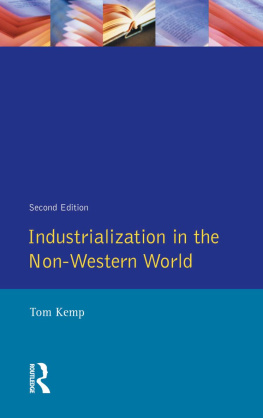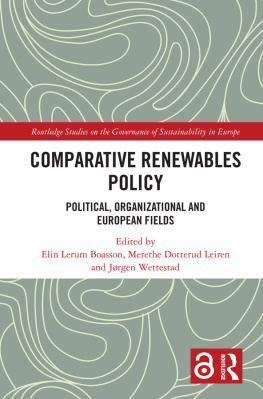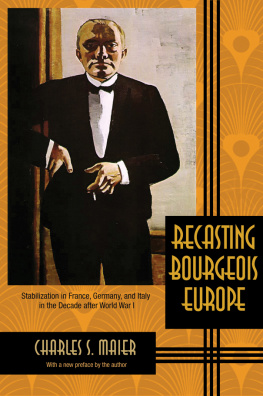INDUSTRIALIZATION IN
NINETEENTH-CENTURY EUROPE
Also available from Longman by Tom Kemp:
Historical Patterns of Industrialization
(Second edition 1992)
Industrialization in the Non-Western world
(Second edition 1989)
Industrialization in Nineteenth-Century Europe
(Second edition 1985)
The Climax of Capitalism (1990)
Industrialization in nineteenth-century Europe
SECOND EDITION
Tom Kemp

First published 1969 by Addison Wesley Longman Limited
Tenth impression 1982
Second edition 1985
Twelfth impression 1997
Published 2013 by Routledge
2 Park Square, Milton Park, Abingdon, Oxon OX14 4RN
711 Third Avenue, New York, NY 10017, USA
Routledge is an imprint of the Taylor & Francis Group, an informa business
Copyright 1969, 1985, Taylor & Francis.
All rights reserved. No part of this book may be reprinted or reproduced or utilised in any form or by any electronic, mechanical, or other means, now known or hereafter invented, including photocopying and recording, or in any information storage or retrieval system, without permission in writing from the publishers.
Notices
Knowledge and best practice in this field are constantly changing. As new research and experience broaden our understanding, changes in research methods, professional practices, or medical treatment may become necessary.
Practitioners and researchers must always rely on their own experience and knowledge in evaluating and using any information, methods, compounds, or experiments described herein. In using such information or methods they should be mindful of their own safety and the safety of others, including parties for whom they have a professional responsibility.
To the fullest extent of the law, neither the Publisher nor the authors, contributors, or editors, assume any liability for any injury and/or damage to persons or property as a matter of products liability, negligence or otherwise, or from any use or operation of any methods, products, instructions, or ideas contained in the material herein.
ISBN 13: 978-0-582-49384-1 (pbk)
British Library Cataloguing in Publication Data
Kemp, Tom
Industrialization in nineteenth-century
Europe. - 2nd ed.
1. EuropeIndustriesHistory
I. Title
338.094 HC240
Library of Congress Cataloging in Publication Data
Kemp, Tom
Industrialization in nineteenth-century Europe.
Bibliographical: p,
Includes index.
1. EuropeIndustriesHistory19th century.
I. Title.
HC240.K39 1985 338.094 8415483
ISBN 0582493846 (pbk.)
This book is intended as a guide for the specialist undergraduate or postgraduate student of European economic history. It therefore takes for granted on the readers part much of the factual knowledge imparted by existing textbooks and directs his attention principally to problems of interpretation. It embarks upon this by putting forward a synthesis and explanation of its own. In this way the student or general reader is offered a coherent view of the field covered and is invited to further study.
The main theme of the following chapters is the industrialization of the European countries in the nineteenth century. The starting point is the Industrial Revolution in Britain, but this is dealt with only to bring out its salient features and to offer a standard of comparison when dealing with industrialization in other national settings. To France, Germany, Russia and Italy the same synthetic treatment is applied. This is not because the author is inclined to believe that the big questions in the economic history of these countries have been solved: on the contrary most of them are still very open. It is considered, however, that it is useful to offer the student some firm hypotheses to begin with rather than to confuse him with a mass of perhaps conflicting data and a diversity of views. Because many economic historians are unwilling to commit themselves on many of the larger matters of interpretation for reasons which may in themselves be sound the student is frequently baffled and finds himself at sea amidst a swelling mass of monographs and articles. Here, then, is an attempt to bring him a lifeline on which he can steady himself to deal with the flood of conflicting opinion and detailed research which will later confront him.
The emphasis on European economic history is intended to counter act what appears to be a distinctly insular trend in much of the teaching which takes place in British universities at the present day. Probably in no other country in the world has the discipline of economic history assumed such an important place in the universities, yet interest in the economic history of other countries is not very strong. As can be seen from the bibliography, there is remarkably little writing in English on the economic history of countries which have been so important for Britain as, for example, Germany. Practically no research has been done on the economic history of nineteenth-century Europe by British economic historians until comparatively recent years. Yet as study of the British industrial revolution proceeds it becomes increasingly apparent that it cannot be understood in isolation from developments outside the British Isles, or without fuller study of comparable processes elsewhere. Such a study should begin with those countries which were nearest to Britain geographically as well as in their cultural heritage. Perhaps no aspect of modem European history has been more neglected than the economic side, yet recent political, as well as economic, developments show how dangerous this ignorance can be.
It may seem that this book gives the reader ready-made opinions. That is not the intention. Presented with a firm interpretation he is being called upon at the same time to think about it and, if he is curious enough, as he should be, to test it. In any case, he will need to refer to other works for description and narrative and in the bibliography his attention is called to the principal books and articles in which the problems may be considered further. As an additional aid to orientation in study and research a list of problems for further investigation, or perhaps for classroom discussion, has been placed at the end of each chapter. The problems themselves have not necessarily been dealt with adequately in the text, but help in pursuing them will be found in the items in the bibliography.
Chronologically the treatment is limited to the pre-1914 period. The justification for this is that the main emphasis is on the conditions in which the foundations were laid for industrialization, not with the further working out of the process of economic growth in advanced industrial societies. Furthermore, the First World War marked the end of a distinctive era in European economic history and brought onto the scene a complex of new problems which changed considerably the character of the next period. There are more books available to the student dealing with this later period than for the nineteenth century, yet an understanding of the problems of current economic development requires a firm foundation in nineteenth-century economic history. It was in this period that the economies of Europe assumed their specific characteristics and direction; their subsequent problems were set and in large measure worked out under the shadow of their earlier history. In the case of Britain, for example, it is impossible to , lay well back in the nineteenth century. Perhaps, too, a fuller understanding of history will not only show what is new on the contemporary economic scene, but will also reveal the constants in the economic and social life of the various countries which have to be taken into consideration at the present time. In some ways it is true that the exigencies of industrialism and urban living tended to make the advanced countries of the world more alike, but underneath appearances they retain specific features derived from their history which these chapters may do something to demonstrate and explain.
Next page
















